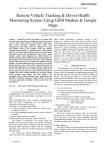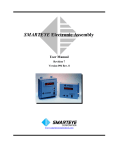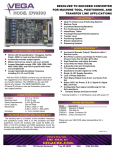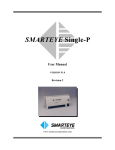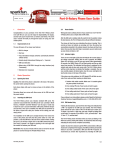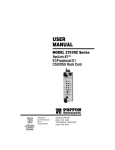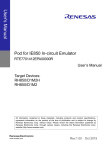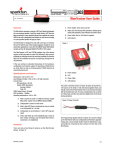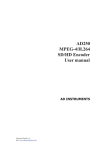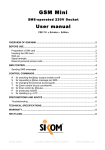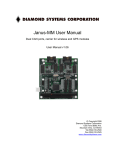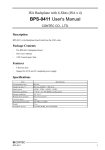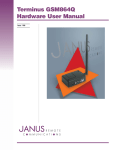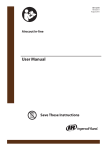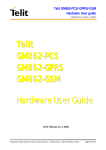Download PC/104 Advanced Communications Module
Transcript
PCM-36E06 PC/104 Advanced Communications Module User Manual Rev 0.2 +DISCLAIMER ................................................................................................................ 3 INTRODUCTION............................................................................................................. 4 GPS MODULE ............................................................................................................... 4 DIAL-UP MODEM MODULE ...................................................................................... 5 CELL MODEM MODULE ............................................................................................ 5 SPECIFICATIONS........................................................................................................... 5 UARTS ........................................................................................................................... 5 GPS MODULE ............................................................................................................... 5 CELL MODEM MODULE ............................................................................................ 6 DIAL-UP MODEM MODULE ...................................................................................... 6 MECHANICAL AND ENVIRONMENTAL................................................................. 6 CONFIGURATION.......................................................................................................... 6 SETTING THE UART I/O ADDRESSES ..................................................................... 6 IRQ SELECTION........................................................................................................... 7 CELL MODEM CONFIGURATION ............................................................................ 7 CONNECTORS ................................................................................................................ 8 HDR1: CONFIGURATION ........................................................................................... 8 HDR2: UART 1, RS-232 PORT..................................................................................... 8 HDR3: DIAL-UP MODEM SPEAKER......................................................................... 8 JK1: PHONE LINE JACK.............................................................................................. 8 CONTROL REGISTER................................................................................................... 9 2 PRELIMINARY SUBJECT TO CHANGE WITHOUT NOTICE DISCLAIMER EMAC Inc. does not assume any liability arising out of the application or use of any of its products or designs. Products designed or distributed by EMAC Inc. are not intended for, or authorized to be used in, applications such as life support systems or for any other use in which the failure of the product could potentially result in personal injury, death or property damage. If EMAC Inc. products are used in any of the aforementioned unintended or unauthorized applications, Purchaser shall indemnify and hold EMAC Inc. and its employees and officers harmless against all claims, costs, damages, expenses, and attorney fees that may directly or indirectly arise out of any claim of personal injury, death or property damage associated with such unintended or unauthorized use, even if it is alleged that EMAC Inc. was negligent in the design or manufacture of the product. EMAC Inc. reserves the right to make changes to any products with the intent to improve overall quality, without further notification. 3 PRELIMINARY SUBJECT TO CHANGE WITHOUT NOTICE INTRODUCTION The PCM-36E06 is a PC/104 Advanced Communication Module with the following features: 8-Bit PC/104 card with 16-Bit pass-through. Dual standard 16550 on-board UARTs with address & IRQ jumper selection. Solid and proven Trimble(r) 12-channel GPS engine, provides accurate performance, and is a Cost-effective GPS solution GPRS/GSM/PCS Cell Modem with internal TCP/IP stack with AT command control. GSM Tri Band 900/1800/1900 MHz International Cell Modem. Provision for Multi-Tech Socket Modem products, including 2400 to 56K baud dial-up modems, Bluetooth Modules with planned support for future communication technologies. Additional RS232 Serial Port. Single 5 Volt supply Operation. Compatible with virtually all Operating Systems including Linux, WinCE, WinXP and DOS. The combination of GPS and a GPRS/GSM/PCS modem on a single PC/104 module is extremely useful. Any GPS application that needs to communicate will by nature require a wireless connection. The PCM-36E06, GPS/GPRS combination is an unprecedented value when both GPS and a Cell Modem are required. The PCM-36E06 uses a 16550 compatible dual UART as the interface to communicate to the GPS, Cell Modem and Dial-Up Modem. Jumpers allow each UART to be individually mapped to different I/O locations and there are also jumpers to select the desired interrupt for each UART. Different component populations allow UART channel 1 to be configured for RS-232 Serial port or GPS communication, and channel 2 can be configured as a Dial-Up or GPRS/GSM/PCS Fax/Modem. There are many combinations possible, but not all may be available off-the-shelf. See www.emacinc.com for listings of the currently supported off-the-shelf combinations or contact [email protected] to discuss a custom combination. Following are summaries of the different modules. GPS MODULE The GPS engine used is the Trimble® Lassen iQ, a 12-channel parallel tracking engine which is ideally suited for embedded applications. The GPS uses a sophisticated satellite technology to locate and track any location in the world, in real-time. The Lassen iQ GPS receiver outputs a complete position, velocity, and time (PVT) solution in either NMEA version 3.0 ASCII or Trimble TSIP binary protocol. A Pulse-Per-Second (PPS) signal is available for very accurate timing and synchronization applications. This signal can be used to generate a processor interrupt if required. See the Trimble® Lassen iQ PDF for more details. 4 PRELIMINARY SUBJECT TO CHANGE WITHOUT NOTICE DIAL-UP MODEM MODULE The Dial-Up Fax/Modem utilizes a standard Multi-Tech embedded socket modem module. These modem modules come in a variety of speeds from 2400 baud to 56K baud and can be easily exchanged. There are also other modules available from Multi-Tech that can plug into this modem socket, including a Bluetooth module. They have plans to support other emerging communication technologies as well. See the Multi-Tech SocketModem PDFs for more details. CELL MODEM MODULE The Telit GPRS/GSM/PCS Fax/Modem is the ideal solution for remote wireless data communications. It supports 900, 1800, 1900 Mhz bands allowing it to work internationally at packed data rates of up to 85.6Kbps. This GPRS modem also provides an internal TCP/IP stack allowing lower-end operating systems such as DOS to communicate over the Internet. Modem control is handled through the simple and familiar AT command set eliminating the need for custom drivers. See the Telit GM862PCS PDF for more details SPECIFICATIONS UARTS IC: National Semiconductor 16550 compatible PC16552 Dual UART or equivalent. UART Channel 1: RS232 Serial Port or GPS MODULE UART Channel 2: Dial-Up Modem Module or GPRS/GSM Cell Modem. Baud Rate: 50 ~ 115,200 bps. Interrupts: IRQ 3,4,5,6,7,9,10,11,12, or 15, individually selectable or shared. I/O Addressing: I/O address range for each channel is individually jumper selectable from 200 to 3F8 Hex. GPS MODULE Control Chipset: Trimble(r) Colossus RF ASIC & IO-TS DSP, 32-Bit RISC CPU. Receiving Channel: 8-channel, continuous tracking receiver with 32 correlators Receiving Frequency: L1 (1575.42 MHz), C/A code. Protocols: TSIP, TAIP & NMEA. Navigation Update Rate: 1 Hz (1 second). Time to First Fix: Cold start 84 seconds, Warm start 42 seconds, Hot Start 13 seconds. Antenna: Trimble P/N 39265-02 with 15' of cable. GPS has antenna short-circuit detection and protection. 5 PRELIMINARY SUBJECT TO CHANGE WITHOUT NOTICE CELL MODEM MODULE Control Module: Telit GM862-PCS Output Frequency: GSM - 900 Mhz, DCS - 1800 Mhz, PCS-1900 MHz. Output Power: GSM - 2 Watt Peak, DCS - 1 Watt Peak, PCS-1 Watt Peak. Compliance: GPRS class B -class 10. GSM Phase 2/2+. Modem Control: AT Command set with ITU, GSM, GPRS, Telit extensions. Sensitivity: Better than -102 dBm in normal operating conditions. Data Speed: CSD up to 14.4Kbps. Packed Data up to 85.6Kbps. Clock: Real-Time Clock/Calendar with Alarm functionality. Antenna: 50 Ohm, 1.6" high Helical Stub with a cable length of 9". DIAL-UP MODEM MODULE Data Modem: ITU-T V.92/V.90/56K, V.34/33.6K, V.32bis/14.4K, V.22bis/2400 baud. Fax Modem: ITU-T V.17, V.29, V.27, V.21. Approvals: Global Certifications: UL1950, CSA 950, EN 60950, AS 3260, CCC, FCC Part 15. Modem Control: AT Command set. Error Correction: V.42 LAPM, MNP 2-4. Data Compression: V.42bis, MNP Class 5. Modem Speed: 56 Kbps maximum. Fax Speed: 14.4 Kbps maximum.. MECHANICAL AND ENVIRONMENTAL Power Requirements: 5 V ± 5 %, ripples within 50 mV p-p Power Consumption: + 5 V @ 300 mA (typical) Operating Temperature: 0° ~ 60°C (32° ~ 140°F) Operating Humidity: 0% to 95% relative humidity, non-condensing Board Dimensions: 96 mm x 90 mm (3.77" x 3.54") (L x W) Weight: approximately102 g (0.224 lbs.) CONFIGURATION SETTING THE UART I/O ADDRESSES There are two jumper blocks to set the I/O addresses for the UARTS and the control register: JB4 JB5 UART 1 (RS232 Serial port or GPS ) UART 2 (Dial-Up or GPRS/GSM/PCS Fax/Modem) Each jumper block shows a hexadecimal weighted value to the left of it. To determine the address, add the weighted value of each shunt present and add 200 hex to the total. The following table shows the jumper settings for common UART addresses. 6 PRELIMINARY SUBJECT TO CHANGE WITHOUT NOTICE 008 010 3F8 JJ JJ ADDRESSES 3E8 2F8 JJ JJ JJ 2E8 JJ 020 JJ JJ JJ JJ 040 JJ JJ JJ JJ 080 100 JJ JJ JJ JJ JJ JJ For example, if you look at the 2E8 column, the values added would be (008+020+040+080)+200=2E8. IRQ SELECTION There are three jumper blocks for selecting IRQs: JB1 JB2 JB3 UART 1 (RS232 Serial port or GPS ) UART 2 (Dial-Up or GPRS/GSM/PCS Fax/Modem) GPS 1Hz timing signal (PPS). See GPS Module for more details. Only one shunt per jumper block should be used. CELL MODEM CONFIGURATION A SIM must be obtained from your cell service provider and inserted in the cell modem module as shown on the sticker on the module If the cell modem is used for incoming and outgoing server type data exchange communication, an Internet type APN should be requested which provides a Public incoming and outgoing IP address. The cell modem should be queried to make sure it is configured with the correct frequency band for its region. The code for each band is shown below. BAND CODE 0 1 FREQUENCY DCS 1800 MHz PCS 1900 MHz REGION EUROPE U.S. 7 PRELIMINARY SUBJECT TO CHANGE WITHOUT NOTICE The command AT#BND? will return the current band code configuration. If this is not the desired band, the command AT#BND=0 or AT#BND=1 can be used to set it. This is a non-volatile configuration. CONNECTORS HDR1: CONFIGURATION This should not be used. It is only used for configuration during manufacturing. HDR2: UART 1, RS-232 PORT The optional RS-232 serial port connector has the following pin assignments. HDR2 (UART 1) (NOT USED) RECEIVE TRANSMIT (NOT USED) GROUND 1 3 5 7 9 2 4 6 8 10 (NOT USED) RTS CTS (NOT USED) (NOT USED) The pin assignments for the DB9 adaptor that plugs into this header are related, but different. DB9 PIN # 1 2 3 4 5 6 7 8 9 DESCRIPTION (NOT USED) RECEIVE TRANSMIT (NOT USED) GROUND (NOT USED) RTS CTS (NOT USED) HDR3: DIAL-UP MODEM SPEAKER If the dial-up modem is installed, HDR3 allows connecting an external speaker for monitoring the dial-up modem’s call progress. 1- SPEAKER OUTPUT 2- GROUND JK1: PHONE LINE JACK If the dial-up modem is installed, this provides a standard jack for connecting the modem to the phone line. 8 PRELIMINARY SUBJECT TO CHANGE WITHOUT NOTICE CONTROL REGISTER The control register implemented is a single register but it is accessible from two separate I/O addresses. The register addresses are the UART 1 and UART 2 base addresses +7. For example, if UART 1 was at 3F8 and UART 2 was at 2E8, the control register would be accessible at both 3FF (3F8+7) and 2EF (2E8+7). The register is defined as follows: BIT 0 1 2 3 4 5 6 7 NOTES: (1) (2) RD WR(1) FUNCTION Read state of the UART 1 (RS-232 or GPS Module) Interrupt line Read state of the UART 2 (Dial-Up or Cell Modem) Interrupt line Read state of the GPS Pulse-Per-Second (PPS) output line Read state of the ISA reset-in line Read state of the Cell Modem PWRCTL line (reads 1if the Cell Modem is on) Read or Write the state of the active-low reset out (resets the Dial-Up Modem) Read or Write the state of the output port(2) that drives the Cell Modem ON/OFF toggle input. Not used. Reads 0. Writing to a bit without write capability has no effect. The output of this port is inverted before being presented to the ON/OFF pin of the Cell Modem, so it is active high. A one-second (min) high pulse is required to change the ON/OFF state of the Cell Modem (reflected by the PWRCTL monitor bit). If PWCTL is 1, a 1 second pulse will turn OFF the modem. If PWCTL is 0, a 1 second pulse will turn ON the modem. 9 PRELIMINARY SUBJECT TO CHANGE WITHOUT NOTICE









